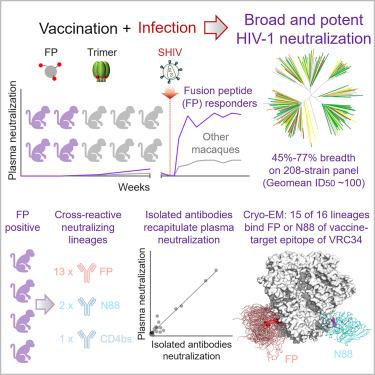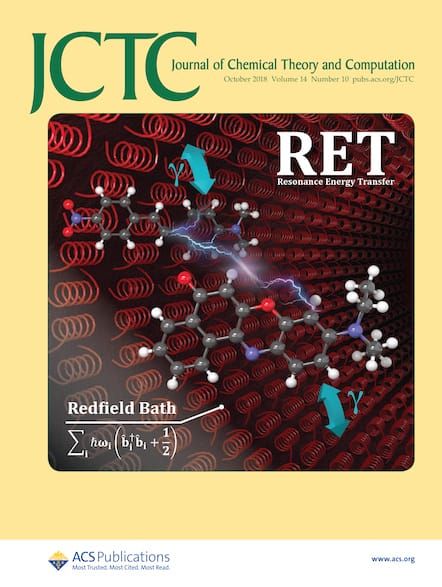在以融合肽为前体的 SHIV 感染猕猴体内发挥强效、广泛的 HIV-1 中和作用
IF 5.7
1区 化学
Q2 CHEMISTRY, PHYSICAL
引用次数: 0
摘要
基于抗体的 HIV-1 疫苗需要诱导强效的交叉反应性 HIV-1 中和反应。为了证明实现这一目标的可行性,我们将针对融合肽易感位点的疫苗接种与猿人免疫缺陷病毒(SHIV)感染相结合。在疫苗诱导中和反应的四只猕猴中,SHIV 感染将血浆中和浓度提高到了 45%-77% 的广度(几何平均 50% 抑制稀释 [ID50] ∼100)。通过抗体分离和低温电子显微镜(cryo-EM)结构测定对这些反应进行分子剖析后发现,在16种具有跨族中和作用的抗体系中,有15种是针对融合肽的易感部位的。在每只猕猴中,从记忆B细胞中分离出的抗体都再现了血浆中和反应,融合肽结合抗体的广度达到40%-60%(50%抑制浓度[IC50] <50微克/毫升),总系浓度估计为50-200微克/毫升。纵向映射表明,这些反应是在感染 SHIV 之前产生的。总之,这些结果提供了一个到几个 B 细胞系产生强效、广泛中和血浆反应的体内分子实例。本文章由计算机程序翻译,如有差异,请以英文原文为准。

Potent and broad HIV-1 neutralization in fusion peptide-primed SHIV-infected macaques
An antibody-based HIV-1 vaccine will require the induction of potent cross-reactive HIV-1-neutralizing responses. To demonstrate feasibility toward this goal, we combined vaccination targeting the fusion-peptide site of vulnerability with infection by simian-human immunodeficiency virus (SHIV). In four macaques with vaccine-induced neutralizing responses, SHIV infection boosted plasma neutralization to 45%–77% breadth (geometric mean 50% inhibitory dilution [ID50] ∼100) on a 208-strain panel. Molecular dissection of these responses by antibody isolation and cryo-electron microscopy (cryo-EM) structure determination revealed 15 of 16 antibody lineages with cross-clade neutralization to be directed toward the fusion-peptide site of vulnerability. In each macaque, isolated antibodies from memory B cells recapitulated the plasma-neutralizing response, with fusion-peptide-binding antibodies reaching breadths of 40%–60% (50% inhibitory concentration [IC50] < 50 μg/mL) and total lineage-concentrations estimates of 50–200 μg/mL. Longitudinal mapping indicated that these responses arose prior to SHIV infection. Collectively, these results provide in vivo molecular examples for one to a few B cell lineages affording potent, broadly neutralizing plasma responses.
求助全文
通过发布文献求助,成功后即可免费获取论文全文。
去求助
来源期刊

Journal of Chemical Theory and Computation
化学-物理:原子、分子和化学物理
CiteScore
9.90
自引率
16.40%
发文量
568
审稿时长
1 months
期刊介绍:
The Journal of Chemical Theory and Computation invites new and original contributions with the understanding that, if accepted, they will not be published elsewhere. Papers reporting new theories, methodology, and/or important applications in quantum electronic structure, molecular dynamics, and statistical mechanics are appropriate for submission to this Journal. Specific topics include advances in or applications of ab initio quantum mechanics, density functional theory, design and properties of new materials, surface science, Monte Carlo simulations, solvation models, QM/MM calculations, biomolecular structure prediction, and molecular dynamics in the broadest sense including gas-phase dynamics, ab initio dynamics, biomolecular dynamics, and protein folding. The Journal does not consider papers that are straightforward applications of known methods including DFT and molecular dynamics. The Journal favors submissions that include advances in theory or methodology with applications to compelling problems.
 求助内容:
求助内容: 应助结果提醒方式:
应助结果提醒方式:


